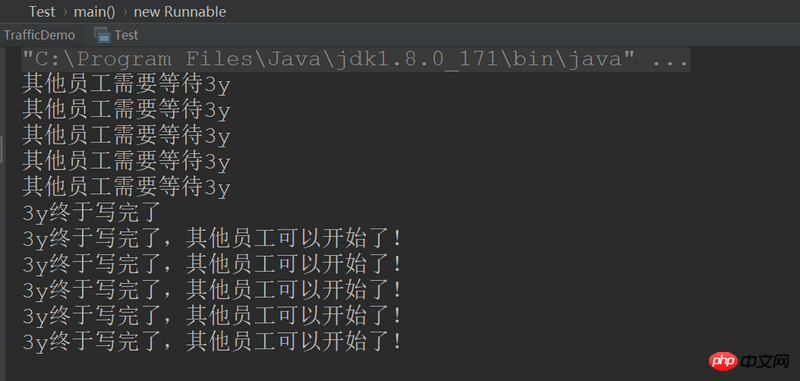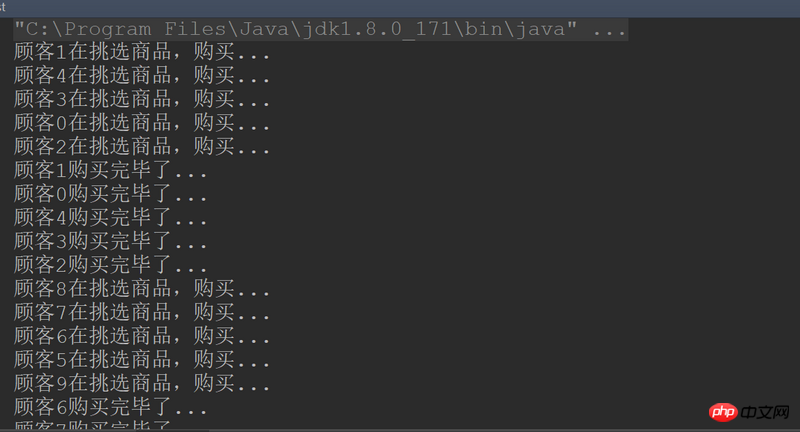 Java
Java
 javaTutorial
javaTutorial
 Summary of knowledge points on three synchronization tools of Java threads, collection notes
Summary of knowledge points on three synchronization tools of Java threads, collection notes
Summary of knowledge points on three synchronization tools of Java threads, collection notes
I recently encountered a question about the three synchronization tool classes of Java threads in an interview. I couldn’t remember it until I reviewed it. I didn’t study the synchronization tool class carefully when I was learning multi-threading, and now I have even forgotten it. Therefore, I reviewed it again and found it quite profound, so I compiled it and wrote an article for your reference. apache php mysql
Java provides us with three synchronization tool classes:
-
CountDownLatch (lock):
## A thread waits for other threads to finish executing before it executes (other threads wait for a thread to finish executing before it executes) - CyclicBarrier (barrier):
A group of threads wait for each other to reach a certain state, and then the group of threads execute at the same time. - Semaphore: Controls a group of threads to execute simultaneously.
better control the communication issues between threads~
1. CountDownLatch1.1 Introduction to CountDownLatchallows one or more threads to wait##A synchronization aid that allows one or more threads to wait until a set of operations being performed in other threads completes.
Simply put: CountDownLatch is a synchronization auxiliary class,
until other threadsCompletetheir operations. There are actually two commonly used APIs: await()
andcountDown()
use Description: 
- countDown()
- to decrement the counter count by 1.
When the count is reduced to 0, all waiting threads will be released
To put it bluntly, the waiting is controlled through the count variable - , If the
count value is 0 (the tasks of other threads have been completed), then execution can continue.
1.2 CountDownLatch example
import java.util.concurrent.CountDownLatch;
public class Test {
public static void main(String[] args) {
final CountDownLatch countDownLatch = new CountDownLatch(5);
System.out.println("现在6点下班了.....");
// 3y线程启动
new Thread(new Runnable() {
@Override
public void run() {
try {
// 这里调用的是await()不是wait()
countDownLatch.await();
} catch (InterruptedException e) {
e.printStackTrace();
}
System.out.println("...其他的5个员工走光了,3y终于可以走了");
}
}).start();
// 其他员工线程启动
for (int i = 0; i < 5; i++) {
new Thread(new Runnable() {
@Override
public void run() {
System.out.println("员工xxxx下班了");
countDownLatch.countDown();
}
}).start();
}
}
}Copy after login
Output result: import java.util.concurrent.CountDownLatch;
public class Test {
public static void main(String[] args) {
final CountDownLatch countDownLatch = new CountDownLatch(5);
System.out.println("现在6点下班了.....");
// 3y线程启动
new Thread(new Runnable() {
@Override
public void run() {
try {
// 这里调用的是await()不是wait()
countDownLatch.await();
} catch (InterruptedException e) {
e.printStackTrace();
}
System.out.println("...其他的5个员工走光了,3y终于可以走了");
}
}).start();
// 其他员工线程启动
for (int i = 0; i < 5; i++) {
new Thread(new Runnable() {
@Override
public void run() {
System.out.println("员工xxxx下班了");
countDownLatch.countDown();
}
}).start();
}
}
}Write another example: 3y is now responsible for the warehouse module function, but his ability is too poor and he writes very slowly,  Other employees need to wait until 3y has finished writing before they can continue writing.
Other employees need to wait until 3y has finished writing before they can continue writing.
import java.util.concurrent.CountDownLatch;
public class Test {
public static void main(String[] args) {
final CountDownLatch countDownLatch = new CountDownLatch(1);
// 3y线程启动
new Thread(new Runnable() {
@Override
public void run() {
try {
Thread.sleep(5);
} catch (InterruptedException e) {
e.printStackTrace();
}
System.out.println("3y终于写完了");
countDownLatch.countDown();
}
}).start();
// 其他员工线程启动
for (int i = 0; i < 5; i++) {
new Thread(new Runnable() {
@Override
public void run() {
System.out.println("其他员工需要等待3y");
try {
countDownLatch.await();
} catch (InterruptedException e) {
e.printStackTrace();
}
System.out.println("3y终于写完了,其他员工可以开始了!");
}
}).start();
}
}
}2. CyclicBarrier
A synchronization aid that allows a set of threads to all wait for each other to reach a common barrier point. CyclicBarriers are useful in programs involving a fixed sized party of threads that must occasionally wait for each other. The barrier is called. It is called cyclic because when all waiting threads are released, CyclicBarrier cancyclic
Reach a certain public barrier point- because it can be re-used after the waiting threads are released.
In simple terms: CyclicBarrier allows a group of threads to wait for each other until
be reused (in contrast to CountDownLatch, which cannot be reused) Instructions for use:
CountDownLatch focuses on
- waiting for other threads to complete
- , and CyclicBarrier focuses on: when the thread
reaches a certain state , it pauses and waits for other threads, all threads arrive After, continue execution.
2.2 CyclicBarrier Example
at
Tiyu West Road subway station, and agreed to send a message to Momentswhen they met each other.
import java.util.concurrent.BrokenBarrierException;
import java.util.concurrent.CyclicBarrier;
public class Test {
public static void main(String[] args) {
final CyclicBarrier CyclicBarrier = new CyclicBarrier(2);
for (int i = 0; i < 2; i++) {
new Thread(() -> {
String name = Thread.currentThread().getName();
if (name.equals("Thread-0")) {
name = "3y";
} else {
name = "女朋友";
}
System.out.println(name + "到了体育西");
try {
// 两个人都要到体育西才能发朋友圈
CyclicBarrier.await();
// 他俩到达了体育西,看见了对方发了一条朋友圈:
System.out.println("跟" + name + "去夜上海吃东西~");
} catch (InterruptedException e) {
e.printStackTrace();
} catch (BrokenBarrierException e) {
e.printStackTrace();
}
}).start();
}
}
}After playing for a day,  each returned home
each returned home
each Chat after taking a shower
import java.util.concurrent.BrokenBarrierException;
import java.util.concurrent.CyclicBarrier;
public class Test {
public static void main(String[] args) {
final CyclicBarrier CyclicBarrier = new CyclicBarrier(2);
for (int i = 0; i < 2; i++) {
new Thread(() -> {
String name = Thread.currentThread().getName();
if (name.equals("Thread-0")) {
name = "3y";
} else {
name = "女朋友";
}
System.out.println(name + "到了体育西");
try {
// 两个人都要到体育西才能发朋友圈
CyclicBarrier.await();
// 他俩到达了体育西,看见了对方发了一条朋友圈:
System.out.println("跟" + name + "去夜上海吃东西~");
// 回家
CyclicBarrier.await();
System.out.println(name + "洗澡");
// 洗澡完之后一起聊天
CyclicBarrier.await();
System.out.println("一起聊天");
} catch (InterruptedException e) {
e.printStackTrace();
} catch (BrokenBarrierException e) {
e.printStackTrace();
}
}).start();
}
}
}三、Semaphore
3.1Semaphore简介
Semaphores are often used to restrict the number of threads than can access some (physical or logical) resource.
A counting semaphore. Conceptually, a semaphore maintains a set of permits. Each {@link #acquire} blocks if necessary until a permit is available, and then takes it. Each {@link #release} adds a permit,potentially releasing a blocking acquirer.However, no actual permit objects are used; the {@code Semaphore} just
keeps a count of the number available and acts accordingly.
Semaphore(信号量)实际上就是可以控制同时访问的线程个数,它维护了一组"许可证"。
当调用
acquire()方法时,会消费一个许可证。如果没有许可证了,会阻塞起来当调用
release()方法时,会添加一个许可证。这些"许可证"的个数其实就是一个count变量罢了~
3.2Semaphore例子
3y女朋友开了一间卖酸奶的小店,小店一次只能容纳5个顾客挑选购买,超过5个就需要排队啦~~~
import java.util.concurrent.Semaphore;
public class Test {
public static void main(String[] args) {
// 假设有50个同时来到酸奶店门口
int nums = 50;
// 酸奶店只能容纳10个人同时挑选酸奶
Semaphore semaphore = new Semaphore(10);
for (int i = 0; i < nums; i++) {
int finalI = i;
new Thread(() -> {
try {
// 有"号"的才能进酸奶店挑选购买
semaphore.acquire();
System.out.println("顾客" + finalI + "在挑选商品,购买...");
// 假设挑选了xx长时间,购买了
Thread.sleep(1000);
// 归还一个许可,后边的就可以进来购买了
System.out.println("顾客" + finalI + "购买完毕了...");
semaphore.release();
} catch (InterruptedException e) {
e.printStackTrace();
}
}).start();
}
}
}输出结果:

反正每次只能5个客户同时进酸奶小店购买挑选。
总结:本文简单的介绍了一下Java多线程的三个同步工具类的用处以及如何用,要深入还得看源码或者查阅其他的资料。如果文章有错的地方欢迎指正,大家互相交流。
相关文章:
相关视频:
The above is the detailed content of Summary of knowledge points on three synchronization tools of Java threads, collection notes. For more information, please follow other related articles on the PHP Chinese website!

Hot AI Tools

Undresser.AI Undress
AI-powered app for creating realistic nude photos

AI Clothes Remover
Online AI tool for removing clothes from photos.

Undress AI Tool
Undress images for free

Clothoff.io
AI clothes remover

Video Face Swap
Swap faces in any video effortlessly with our completely free AI face swap tool!

Hot Article

Hot Tools

Notepad++7.3.1
Easy-to-use and free code editor

SublimeText3 Chinese version
Chinese version, very easy to use

Zend Studio 13.0.1
Powerful PHP integrated development environment

Dreamweaver CS6
Visual web development tools

SublimeText3 Mac version
God-level code editing software (SublimeText3)

Hot Topics
 1393
1393
 52
52
 37
37
 110
110
 Perfect Number in Java
Aug 30, 2024 pm 04:28 PM
Perfect Number in Java
Aug 30, 2024 pm 04:28 PM
Guide to Perfect Number in Java. Here we discuss the Definition, How to check Perfect number in Java?, examples with code implementation.
 Weka in Java
Aug 30, 2024 pm 04:28 PM
Weka in Java
Aug 30, 2024 pm 04:28 PM
Guide to Weka in Java. Here we discuss the Introduction, how to use weka java, the type of platform, and advantages with examples.
 Smith Number in Java
Aug 30, 2024 pm 04:28 PM
Smith Number in Java
Aug 30, 2024 pm 04:28 PM
Guide to Smith Number in Java. Here we discuss the Definition, How to check smith number in Java? example with code implementation.
 Java Spring Interview Questions
Aug 30, 2024 pm 04:29 PM
Java Spring Interview Questions
Aug 30, 2024 pm 04:29 PM
In this article, we have kept the most asked Java Spring Interview Questions with their detailed answers. So that you can crack the interview.
 Break or return from Java 8 stream forEach?
Feb 07, 2025 pm 12:09 PM
Break or return from Java 8 stream forEach?
Feb 07, 2025 pm 12:09 PM
Java 8 introduces the Stream API, providing a powerful and expressive way to process data collections. However, a common question when using Stream is: How to break or return from a forEach operation? Traditional loops allow for early interruption or return, but Stream's forEach method does not directly support this method. This article will explain the reasons and explore alternative methods for implementing premature termination in Stream processing systems. Further reading: Java Stream API improvements Understand Stream forEach The forEach method is a terminal operation that performs one operation on each element in the Stream. Its design intention is
 TimeStamp to Date in Java
Aug 30, 2024 pm 04:28 PM
TimeStamp to Date in Java
Aug 30, 2024 pm 04:28 PM
Guide to TimeStamp to Date in Java. Here we also discuss the introduction and how to convert timestamp to date in java along with examples.
 Java Program to Find the Volume of Capsule
Feb 07, 2025 am 11:37 AM
Java Program to Find the Volume of Capsule
Feb 07, 2025 am 11:37 AM
Capsules are three-dimensional geometric figures, composed of a cylinder and a hemisphere at both ends. The volume of the capsule can be calculated by adding the volume of the cylinder and the volume of the hemisphere at both ends. This tutorial will discuss how to calculate the volume of a given capsule in Java using different methods. Capsule volume formula The formula for capsule volume is as follows: Capsule volume = Cylindrical volume Volume Two hemisphere volume in, r: The radius of the hemisphere. h: The height of the cylinder (excluding the hemisphere). Example 1 enter Radius = 5 units Height = 10 units Output Volume = 1570.8 cubic units explain Calculate volume using formula: Volume = π × r2 × h (4
 Create the Future: Java Programming for Absolute Beginners
Oct 13, 2024 pm 01:32 PM
Create the Future: Java Programming for Absolute Beginners
Oct 13, 2024 pm 01:32 PM
Java is a popular programming language that can be learned by both beginners and experienced developers. This tutorial starts with basic concepts and progresses through advanced topics. After installing the Java Development Kit, you can practice programming by creating a simple "Hello, World!" program. After you understand the code, use the command prompt to compile and run the program, and "Hello, World!" will be output on the console. Learning Java starts your programming journey, and as your mastery deepens, you can create more complex applications.



